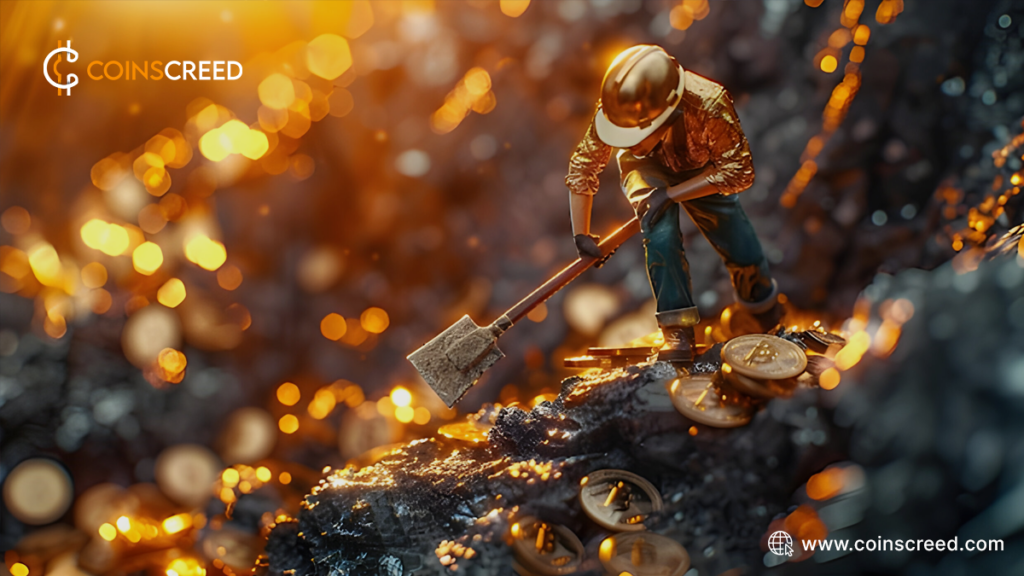Coin mining, or cryptocurrency mining, is the process of creating new digital coins or tokens and verifying transactions on a blockchain network.

This operation in decentralized currencies is essential in maintaining the security and integrity of blockchain networks like Bitcoin, Ethereum, and many others.
In this article, we will discuss the mechanics of coin mining, how it works, the different methods involved, and the potential profitability of mining.
What is Coin Mining?
Coin mining is a decentralized process where individuals (miners) use computational power to solve complex mathematical problems. These problems are tied to transactions on a blockchain network. Once solved, these transactions are added to the blockchain, and the miners are rewarded with a portion of the network’s cryptocurrency.
This process is pivotal to maintaining the decentralized nature of cryptocurrencies, as it ensures that no central authority is needed to verify transactions. Miners effectively act as auditors, confirming the validity of transactions and maintaining the integrity of the blockchain.
How Does Coin Mining Work?
Mining requires three fundamental components: computational power, specialized mining software, and an internet connection to access the blockchain network. The steps of the process are as follows:
Transaction Verification
Transactions are broadcast to the network, and miners collect these into a block. Each block contains multiple transactions that need to be verified.
Solving Complex Algorithms
Miners compete to solve a complex cryptographic puzzle, often called a proof-of-work. This puzzle requires significant computational power and energy consumption to solve.
Adding Blocks to the Blockchain
The first miner to solve the puzzle broadcasts their solution to the network. Once verified by other nodes in the system, the block is added to the blockchain.
Rewards
As a reward for their efforts, the successful miner receives newly minted cryptocurrency (the block reward) and transaction fees from the verified transactions in the block.
This cycle repeats, and miners continuously work to verify and add more transactions to the blockchain.
Types of Coin Mining
There are several different methods to mine cryptocurrencies, with each method catering to various types of miners based on their available hardware, financial resources, and goals. They include:
Proof-of-Work (PoW)
The most common and well-known mining method is Proof-of-Work (PoW), used by Bitcoin and Ethereum (before its shift to Proof-of-Stake). PoW relies on solving mathematical problems to validate transactions and secure the network. Miners using PoW compete for the block reward using high-performance hardware to solve these problems.
Equipment Needed:
- ASIC Miners (Application-Specific Integrated Circuits)
These machines are specifically designed for coin mining and are most efficient for PoW blockchains.
- GPUs (Graphics Processing Units)
Commonly used for mining Ethereum and other altcoins, GPUs offer flexibility in mining multiple cryptocurrencies.
Proof-of-Stake (PoS)
Unlike PoW, Proof-of-Stake (PoS) doesn’t involve solving complex puzzles or requiring heavy computational power. Instead, the probability of validating a block and receiving rewards depends on the number of coins the miner holds or has “staked” in the network. The more coins held, the higher the chances of earning rewards.
PoS is considered a more energy-efficient and environmentally friendly alternative to PoW. Several blockchain networks, including Ethereum, have adopted it since its switch from PoW.
Cloud Mining
Cloud mining allows users to rent computational power from data centers without owning physical mining hardware. Companies offering cloud mining services typically operate large-scale mining farms and lease the processing power to individuals who want to mine coins but lack the resources for an at-home setup.
Advantages of Cloud Mining
- No need for expensive hardware or electricity.
- Easy to get started, even for beginners.
Disadvantages of Cloud Mining
- Lower control over mining operations.
- Potential scams in the cloud mining market.
Solo Mining
As the name suggests, solo miners work independently to solve a block. However, solo mining can be highly competitive, especially in large networks like Bitcoin, where solving a block is difficult without immense computational power.
Pool Mining
To increase their chances of success, many miners join a mining pool, where they combine their computational resources to solve blocks faster. The block rewards are then shared proportionally among the members based on their contribution.
Profitability of Coin Mining
Coin mining can be highly profitable for those who approach it with the right resources, understanding, and strategy. Here’s what miners stand to gain from mining cryptocurrencies:
Block Rewards
The primary incentive for mining is the block reward, which consists of newly minted coins. For every successfully mined block, miners are rewarded with a set number of coins. For example, Bitcoin miners currently receive 6.25 BTC per block (as of 2024). This can be a significant gain, especially if the value of the cryptocurrency rises.
Block rewards provide direct compensation for the computational power used to validate transactions, and for many cryptocurrencies, they serve as the main financial incentive.
Transaction Fees
In addition to block rewards, miners also earn from transaction fees. As the network becomes more congested, users prioritize their transactions by paying higher fees to get them processed quickly. These fees are collected by the miner who successfully mines the block containing those transactions. Over time, as block rewards decrease (like in Bitcoin’s halving process), transaction fees become an increasingly important source of income.
Cryptocurrency Price Appreciation
One of the major benefits of mining is the potential for price appreciation. Miners who accumulate coins during times of low prices can benefit greatly if the value of the cryptocurrency rises.
For example, Bitcoin miners who held onto their coins from previous years when prices were lower have seen significant returns as Bitcoin’s value increased.
Holding coins instead of immediately selling them can offer miners substantial long-term gains if the market trends favor upward movement.
Mining as a Passive Income Source
Once miners have their hardware set up and optimized, mining can be a source of relatively passive income. While mining does require monitoring and periodic upgrades to stay competitive, miners can continuously earn rewards as long as their equipment is running. This makes mining an appealing way to earn cryptocurrency without directly purchasing it from exchanges.
Profits from Scaling Operations
For large-scale miners, profitability comes from economies of scale. By operating mining farms with multiple machines and securing cheap electricity, larger operations can lower their per-unit costs and maximize their gains. This is why regions with low electricity costs and favorable climate conditions (like cold environments) have become popular for large mining operations.
Pool Rewards
Miners who participate in mining pools where multiple miners combine their computational power can gain more consistent payouts. By sharing the work, even small miners can receive steady rewards, reducing the risks and uncertainties associated with solo mining. While pool rewards are shared among participants, the consistency they provide can be more profitable in the long run for smaller or less powerful mining setups.
Legal and Regulatory Considerations
As cryptocurrency adoption grows, governments and regulators worldwide have started imposing laws on mining activities. In some countries, mining is considered legal, while others have implemented outright bans due to concerns over electricity consumption and potential illicit uses of cryptocurrencies. Miners should be aware of the regulations in their jurisdiction to avoid legal consequences.
Is Coin Mining Still Worth It?
With the increasing difficulty, costs of hardware, and environmental concerns, the profitability of coin mining has come under scrutiny. Many argue that PoW mining is becoming a game for large corporations with access to significant resources. However, PoS and cloud mining offer alternatives for those interested in mining without the need for high-end hardware.
Conclusion
Coin mining is a vital aspect of blockchain technology, playing a role in ensuring network security, decentralization, and the creation of new cryptocurrencies. Whether you’re a solo miner or part of a pool, there are numerous ways to mine coins depending on your goals, hardware capabilities, and energy costs.
While challenges such as high electricity consumption and legal regulations exist, the allure of mining for profit remains vital for many. With the rise of more energy-efficient alternatives like PoS, the future of coin mining may look very different from what it does today.
